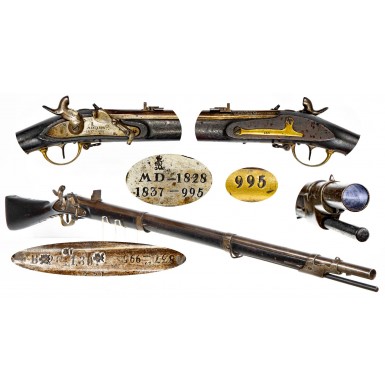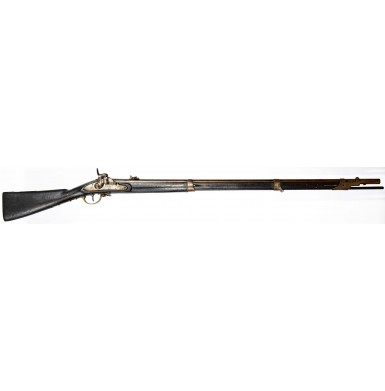Danish Model 1828/46/59 Musket - Scarce
- Product Code: FLA-3626-SOLD
- Availability: Out Of Stock
-
$1.00
In 1814, the Oldenburg Monarchy, also known as the Dano-Norwegian Realm, was partially dissolved due to the defeat of France and Napoleon. This early multi-national union had consisted of Denmark, Norway, the Norwegian controlled islands of Greenland and Iceland, the Duchies of Schleswig and Holstein as well as a number of Dano-Norwegian colonies including the Danish Gold Coast, the Danish West Indies and the Danish Gold Coast, to name a few. The Oldenburg Monarchy had been allies of Napoleon and as a result of his defeat and exile, Norway was ceded to Sweden to seriously curtail the power of the kingdom. This began the ultimate dissolution of the formerly powerful empire.
The ethnically German Duchies of Schleswig and Holstein had felt more Germanic than Dano-Norwegian for most of their existence and as the power of Denmark waned during the second decade of the 19th century, nationalists of the two duchies started to agitate for freedom. This desire to separate themselves from Denmark came to a head in 1848 with the eruption of the First Schleswig War also known as the Three Years’ War. This pitted The German Confederation that consisted of Schleswig and Holstein along with their allies Prussia and Saxony against Denmark with help from Denmark’s former partner in empire Norway, in the form of the Swedish-Norwegian Volunteers. After three year of conflict, the combat concluded in 1851 and a treaty was signed in 1852. The end result left the Duchies of Schleswig and Holstein under Danish control. In February of 1864, the Second Schleswig War (also called the Schleswig-Holstein War) erupted, with the German Confederation, Prussia and the Austrian Empire winning a decisive victory over the Denmark and their Swedish and Norwegian volunteer allies. In August of 1864 the war ended, and Schleswig and Holstein were freed from Denmark. This set the stage for the final unification of Germany that would occur in 1871, after the Austro-Prussian War of 1866 and the Franco-Prussian War of 1870-71.
From the initial joining of the Danish and Norwegian kingdoms during the 1520s, the military power of Denmark and Norway had been combined and the arms and equipment had generally been of the same basic patterns for simplicity of equipage and operations. After the dissolution of the union, the influence of the older Dano-Norwegian arms was still visible in Danish designs, but new patterns began to be developed.
In 1828, the Danes adopted a new pattern of flintlock musket, the Model 1828. The gun was quite similar to the Norwegian Model 1825, which itself was based upon the Swedish Model 1815. In all cases these muskets had evolved from the earlier pinned and wedge retained barrel designs to the French influenced system that used flat, spring-retained bands to secure the barrels. The last of the Dano-Norwegian muskets was the Model 1807. It had used the Kyhl’s pattern flint lock, an “inside” design that resembled the screwless Nock pattern lock with the hammer inside the lock, instead of outside of it. With the adoption of the new pattern of Norwegian M1825 musket and Danish M1828 Musket, the standard “outside” flint lock was reintroduced, although the “dog” that had been common on locks of Dano-Norwegian muskets during the mid-18th century was abandoned. While the Norwegian M1825 was brass mounted like the Swedish gun from which it was derived, the new Danish M1828 was iron mounted with only a brass triggerguard. Both arms relied on the common beech of their environment for stocks and as was common among nations in the region of the Baltic Sea, the arms were often painted black as a system of preserving both the wood and metal from the harsh environment.
The Danish Model 1828 was a traditional muzzleloading, flintlock ignition smooth bore musket with a nominally 41” long, 17.8mm (.70 caliber) barrel secured by three flat, iron, spring-retained bands with the upper band double-strapped. The muskets were nominally 56 ½” in overall length and were stocked in beech. The guns were iron mounted with the exception of a brass triggerguard bow, brass sideplate and a small brass plate in the top of the stock comb that could be used to apply unit designations and rack numbers. Sling swivels were attached at the middle barrel band and on a stud forward of the triggerguard bow. A fixed rear sight was placed on the breech plug tang in same manner as the Prussian Model 1809 muskets and a front sight was attached to the forward strap of the upper barrel band. As with most of the Continental arms of the period, the guns were assembly numbered on most of the components, as the handmade guns were not interchangeable. The design was credited to Danish Colonel Wildenradt and Ordnance Master Kurtzhals, who were clearly influenced by the Swedish and Norwegian patterns that proceeded it. The gun utilized the Danish Kyhl spring secured socket bayonet.
In 1830, the Danes started to experiment with the new percussion cap system of ignition for military arms and in 1841, the percussion cap was officially adopted. Like most nations around the world a system of alteration of the older stocks of flintlock arms to percussion was undertaken. In 1846, the Danes started to apply Weng’s percussion bolster to their flintlock muskets, as was as install percussion hammers that included a safety block similar to those seen on some Austrian arms from the mid-19th century. The pivoting block prevented the hammer nose from contacting the percussion cap when it was placed between the hammer neck and the bolster but would drop out of the way when the musket was placed on full cock, allowing the musket to fire. By 1848, roughly 15,000 Model 1828 muskets had been altered from flint to percussion via this system. These muskets were designated as Model 1828/46. In 1859, roughly 13,000 of the 15,000 percussion altered guns were modified by rifling for use with Minié style ammunition. These guns were further modified by removing the fixed rear sight and adding an adjustable rear sight with a fixed leaf for 200 meters and two additional leaves for longer distance shooting at 400 and 600 meters. This sight was nearly identical in design and appearance to the Saxon Model 1851 rear sight used on the M1851 and M1857 Saxon (Dresden) rifles. This new variant was designated as the Model 1828/46/59. The guns were equipped with a heavy iron ramrod to allow the ramming of the Minié cartridge in the barrel. As would be expected, the percussion altered smoothbore guns saw use during the First Schleswig War and the rifled variants saw use during the Second Schleswig War (Schleswig-Holstein War). Like most of the continental European countries the Danes started to move towards breechloading cartridge rifles and by 1867 had started to adopt the M1867 Remington Rolling Block Rifle as their standard military long arm.
Offered here is a rare Danish Model 1828/46/59 Percussion Musket. The gun is serial number (assembly number) 995 and that number is found throughout the gun. The lock of the musket is clearly marked with the Danish Crown over a script B and below that in two lines:
MD-1828
1837 – 995
This indicates that it was originally a Model 1828, produced in 1837 with the assembly number 995. The percussion alteration hammer and the safety lever are also numbered 995. The barrel is also dated 1837 and numbered 995. Additional barrel markings are obscured by the addition of the long range rear sight and the addition of British commercial proof marks over the original Danish markings. The musket has a nominally .72 caliber (17.9mm) and although it has the 1859 modification with the added long range rear sight (and the removal of the fixed sight), the bore is now smooth. This smooth bore may be explained by the presence of the pair of English Birmingham commercial proof and view marks, as well as the gauge mark 12, which is nominally .72 caliber. My hypothesis is that the gun was sold at surplus as some point in time to an English arms dealer who imported it to England, which by law required the addition of British proof marks. It is likely that the gun was “smooth bored” by the English dealer who then sold the gun as a trade musket, possibly to the North-West Coast of America or somewhere else in the world during the third quarter of the 19thcentury. That would explain the existence of the musket in America, a pattern and model that is rarely encountered in this country. Whether the gun was sold by the Danes once it was obsolete and the Remington Rolling Blocks were in service, or whether it was captured during the Schleswig-Holstein War and sold as part of the spoils of that war is unknown.
The musket remains in about VERY GOOD+ overall condition. The metal is mostly smooth with an attractive, smoothly oxidized brownish patina. There are some areas of lightly scattered surface oxidation with some minor roughness and a small amount of scattered pitting here and there. All markings remain clear and crisp with the only the barrel markings being partially obscured by the added rear sight and the applied British proof marks. The lock remains fully functional and operates crisply on all positions. The hammer block safety remains intact and fully functional as well. The 1859 modification rear sight is in place and functions correctly as well. Both sling swivels also remain in place. The ramrod is an old, wooden replacement. This also suggests potential use as a trade musket at some point during the service life of the gun. The bore of the musket is in about good to very good condition. It remains partly bright with some areas of oxidation and discoloration with scattered light pitting along its length. The stock is in VERY GOOD+ condition as well. It is solid and full-length with no noted breaks or repairs. The beech stock retains some traces of the original Danish black paint. The stock retains good edges and lines and does not appear to have been sanded. As would be expected, the stock shows numerous bumps, dings, minor mars and impact marks, as well as some scuffs and scrapes. All appear to be part of the expected mars one would find on a military musket that saw a service life of at least two decades in the military and saw additional service as a civilian arm during the latter part of the 1800s.
Overall this is a very attractive and interesting continental musket that is not regularly seen for sale in America. These Danish Model 1828/46/59 Muskets had a long and interesting service life, initially as smoothbore flintlocks, then as smoothbore percussion arms and finally as rifled percussion arms. Much like the French, the Danes saw no reason to abandon a perfectly functional musket design and sought to continually upgrade their obsolete guns to keep them in service. This is certainly one of those guns that you wish could talk, at least so the story of the Birmingham proof marks and how this gun ended up in America could be told. This would be a fine addition to any collection of 19th century European military arms and certainly a gun not commonly encountered in American arms collections.
I am deeply indebted to my friend and European arms collector Marc Schwalm, co-author of European Arms In The Civil War, whose assistance was essential in developing this description, as there is practically no information in the English language on Dansih muzzleloading military arms.
SOLD
Tags: Danish, Model, 1828/46/59, Musket, Scarce














